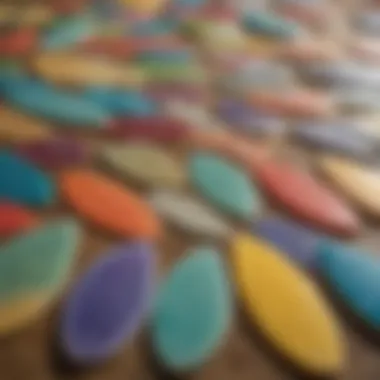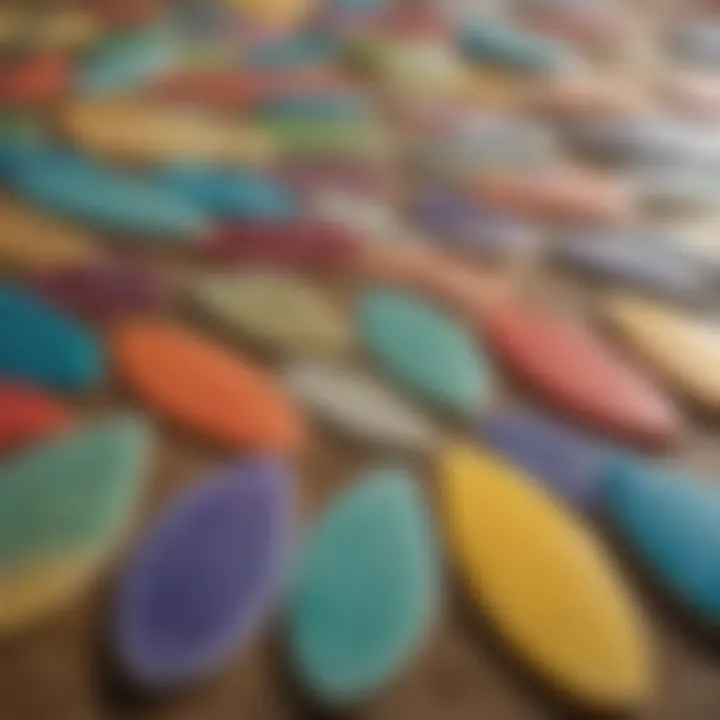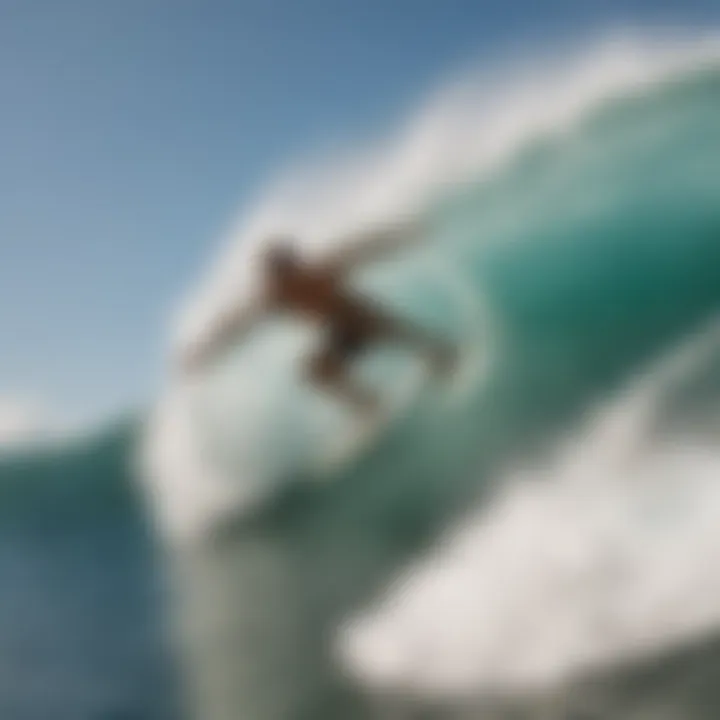Exploring Skimboard Wax: Performance and Sustainability


Intro
Skimboarding, a thrilling sport that calls for agility and balance, has gained favor among outdoor adventurers and water sports enthusiasts alike. One pivotal factor contributing to a skimboarder's prowess lies not just in their technique but in the subtle yet significant role of skimboard wax. This unassuming product enhances performance on the water by fine-tuning the board's grip and maneuverability, allowing riders to carve, slide, and jump with precision.
Brace yourself as we dive into the essential skills and techniques that ensure you're making the most of your time on the water while keeping sustainability in mind. Let's get started!
Techniques and Skills
Fundamental Techniques for Beginners
For those just stepping into the world of skimboarding, grasping the basics is crucial. The initial encounters may seem daunting, but with the right techniques, one can find joy in every glide. Here are some foundational skills:
- Foot Placement: Proper foot positioning is vital. Keep your feet shoulder-width apart, positioning your back foot directly over the tail for optimal control.
- Starting Position: Bend your knees slightly, with your weight centered. This stance allows for better balance as you push off the sand.
- Paddling Out: When you start from the shore, paddle out to a flat section of the water, allowing the waves to assist in gaining speed.
"Understanding how to position yourself can make all the difference when you hit that water."
Advanced Skills for Experienced Athletes
Once you've mastered the basics, it's time to up the ante. Experienced riders can explore complex maneuvers that push their limits:
- Slide Techniques: Learning how to slide effectively can add flair to your performance. Begin with a small surface area, focusing on controlling your weight during the slide.
- Spin and Flip: These tricks require precision and timing. Utilize your arms and shoulders to maintain balance and push off at the right moment.
- Wave Riding: For those who like to incorporate waves, timing becomes essential. Align your movements with incoming swells, letting the wave propel you.
As a seasoned skimboarder, don't forget that your choice of wax can drastically influence your grip and ease with which you perform these advanced maneuvers. Selecting the right wax for current weather conditions can be the difference between a successful maneuver and a wipeout.
Safety and Gear
Essential Safety Measures in Watersports
Engaging in skimboarding does come with its perils. It's crucial to prioritize safety:
- Wear Protective Gear: A helmet and knee pads can save you from nasty falls.
- Check the Environment: Look out for rocks or shallow areas that can cause injury.
- Stay Aware of Your Surroundings: Maintain a safe distance from others to prevent collisions.
Gear Reviews and Recommendations
Now, let’s shift gears and talk about some recommended gear that can enhance your skimboarding experience. Here are a few notable suggestions:
- Skim Boards: Companies like Victoria Skimboards and Zap Skimboards offer a variety of options to fit different skill levels.
- Wax: Brands such as Sticky Bumps and Mr. Zogs boast an impressive range of wax tailored to both warm and cold water conditions.
Before making any purchase, it’s advisable to read user reviews and understand which items align well with your personal style and needs.
In summation, understanding the significance of skimboard wax and combining it with effective techniques is vital for any enthusiast. This intricate dance of skill, choice, and care propels any skimboarder to reach new heights, enriching their experience as they conquer the waves.
Preface to Skimboarding
Skimboarding is more than just a sport; it’s a way of life intimately connected to the ocean's rhythms. By gliding effortlessly across the shore and riding the waves, skimboarders experience a unique blend of thrill and tranquility. Understanding skimboarding is vital for anyone looking to improve their performance on the board. It encapsulates essential elements such as technique, equipment, and the environmental factors that can make or break a session.
From beginners who are still finding their footing to seasoned riders slicing through the surf, every skimboard enthusiast can agree: the right gear enhances not only performance but also enjoyment. One of the key aspects of this is knowing how gear, especially wax, interacts with different types of boards and conditions. Choosing the right equipment ensures that we don’t just skim the surface, but dig deeper into every wave presented.
History of Skimboarding
To appreciate where skimboarding is today, it’s essential to look into its past. Origins of this exciting sport can be traced back to the picturesque beaches of Laguna Beach, California, during the late 1920s. Initially, skimboarding was a simple affair; surfers, eager to extend their fun on the beach, used flat wooden boards to glide over gentle waves, purely for entertainment. It was an informal pastime, often observed with a sense of camaraderie and shared laughter.
As time rolled on, skimboarding transformed from a casual beach activity into a recognized sport. By the 1960s, competition began to sprout, introducing structured events and pushing the boundaries of performance. Skimboard shapes evolved with the technology available, leading to lighter materials and better designs that catered to specific styles, whether it was racing along the shoreline or performing aerial tricks. Each step of this evolution brought a different dimension to the sport.
The Evolution of Skimboarding Gear
The journey from primitive wooden boards to today’s high-tech skimboards highlights impressive advancements in design and materials. Early skimboards were often handcrafted, and while they served their purpose, they didn’t capitalize on the science of hydrodynamics.
Now, skimboarding gear features materials such as fiberglass and foam, offering durability and flexibility. Boards come tailored for various conditions and styles, whether you’re carving through flat days or catching high waves.
Key developments include:
- Board Materials: The shift from solid wood to composite materials changed the weight and responsiveness of boards.
- Shape and Design: Modern boards often have concave shapes for better grip and streamlined edges to minimize drag.
- Skimboard Wax: Perhaps one of the most underrated elements, wax developed significant varieties to cater to different conditions, solidifying its role in the skimboarding experience.
Moreover, the importance of environment-friendly practices cannot be overstated in this gear evolution. Many brands are now focusing on producing sustainable alternatives, catering not just to the riders’ needs but also to the health of our oceans.
"In skimboarding, every detail counts, from the board's design to the type of wax used. Understanding these elements enhances both performance and connection to the beach culture."
Understanding the Purpose of Skimboard Wax


Skimboard wax serves a crucial function for enthusiasts of this exhilarating water sport. Without the right wax, the joy of gliding across the waves diminishes significantly. The purpose of skimboard wax isn’t merely a matter of preference; it fundamentally influences the rider's experience, safety, and performance. By examining these factors, we can better appreciate the vital role wax plays in skimboarding.
Importance of Traction
Traction is king. The ability of a skimboarder to maintain control while riding can make or break the experience. A proper layer of wax enhances grip between a rider's feet and the board. When a skimboarder is charging down towards the water, a good grip allows for confident maneuvers off the beach. If the wax is inadequate or worn, riders might find themselves slipping unexpectedly, leading to falls and potential injuries.
The right wax creates a textured surface that works with the foot's natural movement, allowing for better responsiveness. This isn’t just about comfort; it’s about control in the unpredictable element of water. Without good traction, one might as well be trying to dance on ice.
Key Takeaways about Traction:
- Essential for Safety
- Affects Confidence Level
- Influences Performance Quality
Influence on Performance
Performance on a skimboard goes beyond the basics of speed. Wax directly impacts how well the board glides over the water and how effectively the rider can maneuver. When applied correctly, wax improves an individual’s ability to carve turns, catch waves, and perform tricks without hesitation.
Moreover, different types of wax can modify how the board interacts with the water. For instance, softer wax offers more grip, which can be beneficial in lower temperatures or when riding smaller waves. Conversely, harder wax might be preferable in warmer climates, promoting faster speeds due to decreased drag.
"The right skimboard wax can be the difference between feeling like you're riding on clouds and struggling through molasses."
In summary, understanding the purpose of skimboard wax is essential for any rider aiming to elevate their experience. With traction being vital for safety and control, and performance being intricately linked to the type and application of wax, the choices a rider makes about this seemingly simple item have far-reaching implications. Thus, investing time in selecting and applying the right wax leads to a significantly improved skimboarding experience.
Types of Skimboard Wax
When exploring the world of skimboarding, understanding the various types of skimboard wax is pivotal. The right wax can significantly enhance your performance, providing the necessary grip and control over your movements on the board. Each type holds its unique qualities, catering to distinct riding styles and environmental conditions, which makes knowing the differences essential for any serious rider.
Soft vs. Hard Wax
When it comes to choosing between soft and hard wax, it's not all black and white.
- Soft Wax: Typically props up riders looking for a more tactile feel. This wax gives a little under pressure, allowing for quicker adjustments during tricks or turns. The trade-off? It tends to wear down faster and may require more frequent applications. So if you're the type who loves to go wild with jumps and spins, soft wax could be your best friend.
- Hard Wax: On the other hand, hard wax serves as a robust companion for those who prioritize endurance over all-out flexibility. It offers longer-lasting grip under high-speed conditions and is less prone to wearing away quickly. For professional skimboarders or those who frequent rocky shores, this could provide the stability needed for sharp and thrilling rides.
Making a choice often hinges on personal riding style. So, it’d be wise to dabble with both during practice sessions and figure out what suits you best.
Temperature-Specific Formulations
Just like a good cup of coffee, skimboard wax comes in various brews designed for specific conditions. Temperature-specific formulations allow riders to optimize their board's traction, depending on the warmth or chill of the water. In warm weather, you might find that a softer wax provides just the right grip for that smooth glide. Conversely, when the temperature dips, a harder formulation might be necessary to combat slick surfaces.
- Warm Water Wax: Tends to stay softer, allowing it to mold to the board and create a strong bond with your feet, perfect for those summer days on the beach.
- Cold Water Wax: Formulated to maintain firmness and durability, even in lower temperatures, ensuring you don’t lose grip when the water is less forgiving.
These considerations aren't trivial; picking the right wax for the temperature can mean the difference between a thrilling ride and an unfortunate slip.
Non-Toxic and Eco-Friendly Options
In a world that's increasingly becoming conscious about environmental impact, the availability of non-toxic and eco-friendly skimboard wax options makes a significant splash. Traditional waxes often contain chemicals that could potentially leach into the water and harm marine life. But now, several brands have stepped up to the challenge, offering formulations that do not compromise on quality.
These eco-friendly alternatives:
- Reduce chemical exposure to local ecosystems.
- Often come from sustainable sources, promoting responsible practices in wax production.
For riders dedicated to preserving the beauty of waterways, opting for non-toxic wax is not just a choice; it’s a commitment to the sport and the planet. Additionally, many of these waxes are specifically designed not to compromise traction. So, there's no need to sacrifice performance at the altar of sustainability.
Choosing eco-friendly skimboard wax isn't only a personal choice; it's a small step towards protecting marine environments for future generations to enjoy.
How to Choose the Right Skimboard Wax
Choosing the right skimboard wax isn’t just about grabbing any tube off the shelf. It’s a decision that can significantly influence your performance on the water. Different waxes cater to diverse conditions, materials, and riding styles. Hence, taking the time to understand what works best for you can enhance your experience tremendously. Let's break it down into bite-sized pieces.
Assessing Board Material
The type of material your skimboard is made from plays a pivotal role in determining the appropriate wax to use. Common materials include wood and fiberglass, with each favoring different wax properties.
- Wooden Boards: These typically require a softer wax. Softer wax adheres better to the porous surface of wood, offering more traction. It also provides a better grip when you're hitting the waves or gliding across the shoreline.
- Fiberglass Boards: In contrast, fiberglass boards benefit from harder wax. The slicker surface of fiberglass needs a wax that can withstand speed and pressure without melting away too soon. Hard wax offers the durability needed in these scenarios.
Keeping an eye on the specific material of your board will help direct you to the right product. Going against this grain can lead to slips and falls, and you definitely don’t want that on your ride.
Evaluating Water Conditions
Water conditions can fluctuate like a mood ring. Factors like temperature, wave size, and even salinity should guide your wax choice.
- Warmer Water: If you’re skimming in warmer waters, a medium to soft wax can help maintain grip. Here, lighter formulations will hold up better. You don’t want to end up with a gooey mess that melts away under the sun.
- Colder Conditions: For colder, choppy waters, opting for harder wax can ensure stability. It prevents the wax from becoming overly soft, preserving your traction and control.
- Wave Size: High waves demand more from your wax. A harder wax will typically suffice in these scenarios to maintain grip during steep descents and sharp turns.


In summary, match your wax to the water condition and not just blindly pick what you've seen others use. It's all about maximizing grip for your environment.
Personal Preference and Riding Style
The final piece of the puzzle is you. Your own style on the skimboard can sway the best wax for your rides. Consider how you like to skim—do you prefer speed, tricks, or cruising?
- Trick Riders: If you’re doing nose grabs or spins, you might favor a wax that fosters great grip and quick stickiness. Here, a softer wax could work well, giving your feet the adhesion needed for mid-air maneuvers.
- Speed Enthusiasts: For those who seek speed, a harder wax reduces drag. Ultimately, the goal is to find the right balance that lets you perform with ease.
- Style and Comfort: Finally, there’s an element of comfort in how a certain wax feels on your board. If you find a type that feels right for your feet, stick with it. Your comfort can heavily influence performance.
Remember, there isn't a one-size-fits-all answer. Keeping your personal preferences front and center can make all the difference in your rides on water.
“In the world of skimboarding, the right wax can be the silent partner in your performance—crucial, yet often overlooked.”
Ultimately, finding the right skimboard wax involves assessing your board material, evaluating water conditions, and factoring in your unique style and preferences. With these considerations, you’ll choose a wax that not only fits your board but also enhances your skimboarding experience.
Application Techniques for Skimboard Wax
Proper application techniques for skimboard wax can significantly enhance your glide on the water, making it an integral topic for any enthusiast. Waxing is not just a ritual; it involves a nuanced understanding of your board's surface and riding conditions. The benefits are myriad: improved grip, better maneuverability, and extended wax longevity. Knowing how to apply wax correctly not only boosts performance but also shields your board from damage by ensuring the right amount is used.
Preparing the Board Surface
Before applying any wax, it’s crucial to prepare the skimboard surface adequately. This step can't be stressed enough, as a clean board will catch the wax better and provide optimal grip on the water. First, use a clean cloth or soft sponge to wipe down the board, removing any dust or debris that may have accrued since your last outing. Look around every nook and cranny, especially the tail and edges, because dirt there can ruin your meticulous wax job.
Once you've wiped it down, inspect for any imperfections. If there are deep scratches or dents, consider lightly sanding the area with a fine grit paper. A smooth surface allows wax to grip effectively, while rough patches can prevent it from adhering properly. After sanding, wipe the board again to ensure it’s completely clean. You want to start with a surface that’s as fresh as a daisy.
Layering Methods for Optimal Grip
When it comes to layering your skimboard wax, technique matters. You don’t just slap it on; there are specific methods that can yield more traction.
- Base Layer: Start with a base layer of soft wax, which is ideal for providing the fundamental grip you need. Apply it in a cross-hatch pattern for even coverage, pressing down firmly but not excessively.
- Top Layer: After establishing your base, you can opt for a harder wax for the top layer to enhance durability. Use a similar cross-hatch method but focus on areas where you anticipate the most usage, like the tail and your foot placement zones.
- Final Touch: Finish with a quick buff using your cloth. This not only smooths the surface but also warms up the wax, helping it attach to the skin of your board.
This layering technique forms a barrier that supports your foot placement, allowing for much better control in waves or flat water.
Determining Application Frequency
Deciding how often to reapply wax is an art in itself. Several factors come into play - type of water activity, frequency of use, and environmental conditions.
- Increased Usage: If you skim daily or frequently, you might find that wax wears down faster, requiring reapplication every few sessions.
- Water Conditions: Saltwater can degrade wax quicker than freshwater, so if you frequent the ocean, keep a close eye on your wax. It never hurts to check after an outing.
- Temperature Changes: Wax performance also hinges on local weather. In warmer climates, your wax may melt and become gooey, leading to a need for more frequent applications.
A good rule of thumb is to inspect your wax's texture before each session. If it feels sticky or looks thin in areas, it’s time to add a layer. By staying mindful of your wax condition, you'll ensure maximized grip when you take the plunge.
Maintaining Skimboard Wax
Maintaining skimboard wax may not be the flashiest topic in the world of skimboarding, but it's undeniably crucial. Just like a well-oiled machine, your skimboard needs attention to perform at its peak. Proper maintenance ensures that the wax provides optimal traction and durability, enabling consistent performance on the water. A neglected board with worn-out wax can lead to slippery rides, lack of control, and potentially frustrating wipeouts. Not only does this impact your fun, but it can also hinder skill progression in a sport where balance and precision are key.
Cleaning Techniques
Keeping your skimboard’s wax in tip-top shape requires regular cleaning. A clean surface helps the wax adhere better and last longer. To clean your board, follow these simple steps:
- Initial Rinse: Start with a brief rinse of fresh water to remove sand and debris. This prepares the surface for deeper cleaning.
- Scrub with a Brush: Use a stiff-bristle brush to scrub the waxed area. This can help remove old wax and dirt that might have built up over time. Be sure to scrub gently to prevent damaging the board’s finish.
- Use Wax Remover: For a more thorough cleaning, consider using a wax remover. Apply it evenly and let it sit for a few minutes to allow it to penetrate. Then scrub again with the brush.
- Final Rinse: Rinse the board thoroughly with fresh water, ensuring no cleaning agents remain.
- Dry Completely: Let the skimboard air dry completely before applying new wax. This step is critical because any moisture can affect wax adhesion.
By maintaining your board’s cleanliness, you extend the lifespan of the wax and ultimately enjoy smoother rides.
Signs of Wear and When to Reapply
Recognizing when it’s time to reapply skimboard wax is as essential as the application itself. There are several telltale signs that should prompt you to pick up your wax again:
- Loss of Grip: If you start to feel yourself slipping or losing grip while riding, it may be time to reapply. This indicates that the wax has worn down.
- Visible Discoloration: Wax can change color or turn gummy when it’s past its prime. If you notice changes in texture or color, it’s a sign.
- Chipping or Breaking Off: When you see pieces breaking away or chipping off on the board, it’s definitely time for a refresh.
In general, it’s good practice to check the wax after every session, especially in varying water conditions. High heat or cold temperatures can hasten wear and tear on wax. Regular inspections ensure you maintain that edge you need to ride confidently.
"A well-maintained skimboard leads to performance that feels natural and instinctive."
Keeping your wax fresh not only impacts your grip but also your enjoyment of the sport. The exhilarating feeling of conquering a wave is only as good as the equipment beneath you.
Environmental Considerations of Skimboard Wax
Skimboarding is an exhilarating sport that thrives on the shores, merging the beauty of nature with adrenaline-fueled performance. However, as more enthusiasts hit the water, the environmental implications of the products they use, namely wax, come into sharper focus. Understanding the environmental considerations around skimboard wax not only highlights its role in performance but also underscores the responsibility all riders share in protecting aquatic ecosystems. In this section, we’ll delve into how skimboard wax can affect marine life and explore sustainable practices within the wax production process.
Impact of Chemicals on Marine Life


Skimboard wax often contains a mix of chemicals designed to enhance grip and performance. These chemicals, while beneficial for the sport, can pose significant dangers to marine ecosystems. When wax wears off in the water or is washed away during cleaning, these substances can seep into the ocean, impacting fish, coral reefs, and overall water quality.
Some common additives in conventional wax formulations can disrupt the delicate balance of marine organisms. For instance, synthetic fragrances and certain dyes can be toxic, leading to harmful effects on aquatic life. Every time a rider waxes or cleans their skimboard, they inadvertently contribute to this cycle unless they choose more eco-friendly options.
"The responsibility of every skimboarder lies not only in their performance but in the stewardship of the waters they ride upon."
As awareness grows, many enthusiasts are beginning to realize the necessity of selecting waxes that are non-toxic and biodegradable. By opting for products that minimize chemical waste, skimboarders can enjoy their passion while safeguarding marine life.
Sustainable Practices in Wax Production
With the rising environmental concerns linked to traditional skimboard wax, manufacturers are increasingly adopting sustainable practices in their production processes. This shift is not only beneficial for the health of the oceans but also offers a promising pathway for the future of skimboarding itself.
- Eco-friendly Ingredients: Many brands are formulating their waxes using natural resins, organic oils, and biodegradable substances. These alternatives are not only safer for marine ecosystems but can also provide effective grip.
- Sustainable Sourcing: Some companies are committing to sourcing materials from sustainable suppliers, ensuring that their entire production chain minimizes environmental impacts. This includes using sustainably harvested plants that can replenish themselves naturally.
- Recycling Initiatives: A growing number of brands are engaging in recycling programs, allowing customers to send back used wax containers for proper disposal or reuse. This reduces waste and promotes a circular economy within the skimboarding community.
- Education and Outreach: Many producers are participating in outreach initiatives to educate riders about the importance of eco-friendly options. They emphasize how the choices they make can considerably affect the health of the oceans.
Shifting the narrative toward sustainability isn't just a marketing trend; it's becoming a core value for many skimboarders. As the sport continues to evolve, it's paramount that enthusiasts recognize their potential to influence the market.
In summation, the environmental considerations surrounding skimboard wax are crucial for ensuring the longevity of marine ecosystems. By understanding the impact of chemical substances and promoting sustainable practices in wax production, both skimboarders and manufacturers can foster a culture of responsibility that enriches the sport while protecting nature.
Innovations in Skimboard Wax Technology
The realm of skimboarding transcends traditional practices and dives into a sphere of continuous innovation, especially when it comes to wax technology. In a sport heavily reliant on optimal performance and safety, advancements in skimboard wax have underscored the importance of adapting to both user needs and environmental consciousness. Modern skimboard wax isn't just about providing traction; it's about enhancing the entire skimboarding experience, ensuring riders can push boundaries while remaining responsible stewards of nature.
Recent Advances in Composition
In recent years, the composition of skimboard wax has moved beyond the basic waxes of the past, leading to enhancements that cater to varying conditions and rider preferences. Innovations include:
- Biodegradable Ingredients: A growing number of companies are now focusing on waxes that are not only effective but also eco-friendly. These waxes use ingredients derived from natural sources, reducing the negative impact on marine life when washed off in the ocean. This shift in composition is essential for those who prioritize both performance and environmental responsibility.
- Temperature-Sensitive Formulations: Another significant advancement is the development of temperature-sensitive waxes. These formulations adjust their grip and consistency based on the surrounding temperature. For instance, a wax that performs excellently in warm waters might become too stiff in colder environments. Companies look to refine these formulations, so riders have the right wax, irrespective of the climate they find themselves in.
- Enhanced Durability: Innovations also include creating waxes that last longer without degrading. The incorporation of synthetic additives allows for better performance longevity, which means that riders can spend more time on the water and less time worrying about reapplication—a real plus for those marathon sessions at the beach.
"The game has changed; modern waxes are tailored to user experience while keeping our oceans safe and clean."
Future Trends in Product Development
Looking ahead, several anticipated trends in skimboard wax technology are emerging, promising to further revolutionize the industry:
- Smart Wax Technologies: As technology merges with sports equipment, concepts like smart waxes are on the horizon. These waxes might contain sensors to analyze conditions like water temperature and humidity, providing real-time feedback that helps the rider choose the best wax for their current environment.
- Customization Options: A push towards rider personalization is becoming clearer. Manufacturers may offer customizable wax options, allowing users to choose their preferred grip level, scent, or color. This personalization can enhance not just performance, but also the enjoyment and unique style every rider brings to the sport.
- Sustainable Sourcing: As environmental concerns grow, the industry is likely to see more brands focusing on sustainable sourcing of materials used in wax production. The adoption of harvested resins or recycled materials might become standard practice, reducing waste and promoting a circular economy in product development.
In essence, innovations in skimboard wax technology are propelling the industry into a more sustainable and performance-oriented future. With each advancement, the bond between the rider and the water grows stronger, paving the way for a new era of skimboarding excellence.
Case Studies: Performance Analysis
Understanding the performance dynamics of skimboard wax is not just about choosing a blend off the shelf; it is essential to analyze how various types of wax behave in real conditions. This section emphasizes the need for rigorous case studies that compare different wax formulations in diverse environments. These evaluations can provide insights into everything from grip and slide characteristics to durability under different riding conditions. By examining performance data gathered from these studies, skimboard enthusiasts can make informed decisions when selecting the right wax for their adventures.
Comparison of Wax Types in Various Conditions
When it comes to wax, one size definitely does not fit all. The performance can hinge on several factors such as temperature, humidity, and surface conditions. Here’s how different wax types stack up:
- Soft Wax: Typically favored in cooler climates, soft wax adheres better in low temperatures due to its pliable nature. However, in warmer waters, it can become too sticky, leading to a less desirable ride.
- Hard Wax: Generally preferred in warmer conditions, this type minimizes stickiness due to its firmer composition. It can withstand high temperatures, providing a smooth glide across the water surface.
- Temperature-Specific Wax: These formulations are designed to cater to specific environmental conditions, maximizing performance. For instance, a mixture geared towards tropical conditions would likely outperform generic options in those settings.
Each of these types has its strengths and weaknesses, and understanding these nuances can impact rider satisfaction significantly. Studies reveal that users often switch their wax depending on seasonal changes, illustrating the importance of knowing the type needed for optimal performance in particular conditions.
User Experiences and Testimonials
Nothing beats first-hand accounts when it comes to understanding the effectiveness of skimboard wax. Many riders take to online forums and social media platforms such as Reddit and Facebook to share their experiences with different waxes. Some common themes arise from these testimonials:
- Enhanced Grip: Users often report dramatic improvements in grip with specific wax types, stating that it feels like they can glide better, perform tricks more confidently, and generally enjoy the ride more.
- Durability: Several riders have shared stories about the longevity of certain brands compared to others. For example, one user noted that a particular eco-friendly wax lasted longer in tough conditions than a competitor's product, leading them to remain loyal to that brand.
- Environmental Concerns: Given the increasing awareness around sustainability, many testimonials now highlight the value of choosing non-toxic, eco-friendly waxes. Riders appreciate that they contribute to preserving marine ecosystems while still enjoying their sport.
“Finding the right wax changed my whole game. I used to struggle with slips and falls, but now I can focus on mastering my flips and tricks.”
The End: The Future of Skimboard Wax
As we round the bend towards a new era in skimboarding and its related gear, the role of skimboard wax remains pivotal. The future of skimboard wax is not just about enhancing performance; it’s about harmonizing user needs with environmental considerations.
Integration of User Needs and Environmental Responsibility
In today’s world, water sports enthusiasts are increasingly aware of their impact on the environment. Each ride on the waves now carries a weight that is both exhilarating and burdensome. Users are looking for products that not only deliver exceptional grip and performance but also align with their values concerning sustainability.
What this means for skimboard wax manufacturers is significant:
- Eco-friendly formulations: There’s a growing demand for wax that avoids harmful chemicals. Biodegradable options are becoming more mainstream, encouraging companies to innovate and provide sustainable alternatives.
- User education: Skimboarders should be informed about the ingredients in their wax and the potential harm these could inflict on marine ecosystems.
- Community feedback: Manufacturers who listen to user requests for greater environmental accountability may find loyal customers willing to pay a premium for greener products. Understanding these needs will not only foster brand loyalty but elevate the entire industry towards better practices.
Encouraging Continued Innovation in the Industry
As the sporting landscape evolves, so must the products that support it. Encouraging innovation is essential. The upcoming wave of coatings and formulations should reflect both advanced technology and a commitment to ecological integrity.
- Adoption of new materials: For instance, incorporating plant-based waxes or other natural compounds that maximize grip while minimizing environmental harm could reshape the industry.
- Technological advancements: Imagine a wax that can adapt according to water temperature or salt content, ensuring optimal performance across varying conditions.
- Collaboration with academia and startups: Engaging with research institutions can spawn breakthroughs that seem far-fetched today but can be reality tomorrow. Teams of innovators can develop solutions that we haven’t dreamed up yet.
In essence, the future of skimboard wax lies at the intersection of performance, user mindfulness, and ecological stewardship. As the industry matures, those who engage with these dynamics effectively will not just ride the waves—they will also reshape them.















